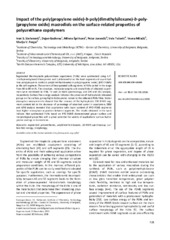Приказ основних података о документу
Impact of the poly(propylene oxide)-b-poly(dimethylsiloxane)-b-poly-(propylene oxide) macrodiols on the surface-related properties of polyurethane copolymers
| dc.creator | Stefanović, Ivan | |
| dc.creator | Gođevac, Dejan | |
| dc.creator | Spirkova, Milena | |
| dc.creator | Jovancic, Petar | |
| dc.creator | Tešević, Vele | |
| dc.creator | Milačić, Vesna | |
| dc.creator | Pergal, Marija | |
| dc.date.accessioned | 2019-01-30T17:51:08Z | |
| dc.date.accessioned | 2023-02-07T09:45:12Z | |
| dc.date.available | 2019-01-30T17:51:08Z | |
| dc.date.available | 2023-02-07T09:45:12Z | |
| dc.date.issued | 2016 | |
| dc.identifier.issn | 0367-598X | |
| dc.identifier.uri | http://TechnoRep.tmf.bg.ac.rs/handle/123456789/5830 | |
| dc.description.abstract | Segmented thermoplastic polyurethane copolymers (PURs) were synthesized using 4,4'-methylenediphenyl diisocyanate and 1,4-butanediol as the hard segment and alpha,omega-dihydroxy-poly(propylene oxide)-b-poly(dimethylsiloxane)-b-poly(propylene oxide) (PPO-PDMS) as the soft segment. The content of incorporated soft segments in PURs varied in the range from 40 to 90 wt.%. The structure, molecular weights and crystallinity of obtained copolymers were monitored by FTIR, H-1- and 2D-NMR spectroscopy, and GPC and DSC analysis, respectively. Surface free energy analysis indicates the presence of hydrophobic (siloxane) groups on the surface, giving highly hydrophobic nature to the obtained PURs films. Water absorption measurements showed that the increase of the hydrophobic PPO-PDMS segment content led to the decrease of percentage of absorbed water in copolymers. SEM and AFM analysis revealed that copolymers with lower content of PPO-PDMS segments have higher microphase separation between segments. The results obtained in this work indicate that synthesized PURs based on PPO-PDMS demonstrated proper surface and morphological properties with a great potential for variety of applications such as hydrophobic coatings in biomedicine. | en |
| dc.publisher | Assoc Chemical Engineers Serbia, Belgrade | |
| dc.relation | info:eu-repo/grantAgreement/MESTD/Basic Research (BR or ON)/172062/RS// | |
| dc.relation | Czech Science Foundation (Grant Agency of the Czech Republic) [13-06700S] | |
| dc.rights | openAccess | |
| dc.rights.uri | https://creativecommons.org/licenses/by-nc-nd/4.0/ | |
| dc.source | Hemijska industrija | |
| dc.subject | segmented polyurethanes | en |
| dc.subject | poly(dimethylsiloxane) | en |
| dc.subject | 2D-NMR spectroscopy | en |
| dc.subject | surface free energy | en |
| dc.subject | morphology | en |
| dc.title | Impact of the poly(propylene oxide)-b-poly(dimethylsiloxane)-b-poly-(propylene oxide) macrodiols on the surface-related properties of polyurethane copolymers | en |
| dc.type | article | |
| dc.rights.license | BY-NC-ND | |
| dc.citation.epage | 738 | |
| dc.citation.issue | 6 | |
| dc.citation.other | 70(6): 725-738 | |
| dc.citation.rank | M23 | |
| dc.citation.spage | 725 | |
| dc.citation.volume | 70 | |
| dc.identifier.doi | 10.2298/HEMIND151127009S | |
| dc.identifier.fulltext | http://TechnoRep.tmf.bg.ac.rs/bitstream/id/15425/1987.pdf | |
| dc.identifier.scopus | 2-s2.0-85011867229 | |
| dc.identifier.wos | 000392310700012 | |
| dc.type.version | publishedVersion |

